Dubrovnik, Croatia
August 3-9, 2010
There are 67 pictures here.
I took a bus from Mostar to Dubrovnik, and then spent
six nights in Dubrovnik. We passed over this bridge on the way into town.
E001

I stayed at a sobe run by Paulina Čumbelič, a very kind,
gentle woman renting four old-fashioned rooms. I was in room number 4, which was
upstairs, and right outside the window were clothes lines on a pulley. That was
great as I could wash clothes and hang them outside to dry. The windows were
open all the time, and there were no mosquitoes or other flying critters. The
place was right near the Pile Gate (Pee-lay), the main entrance to the Old Town.
Some 500 years ago, Dubrovnik was a major maritime
power, with the third-biggest navy in the Mediterranean. Busy merchants, the
salt trade, and shipbuilding made Dubrovnik rich. In the Middle Ages, the
city-state of Dubrovnik (then called Ragusa) bought its independence from
whoever was strongest – Byzantium, Venice, Hungary, the Ottomans – sometimes
paying off more than one at a time. Dubrovnik’s ships flew whichever flags were
necessary to stay free.
Dubrovnik flourished in the 15th and 16th
centuries, but an earthquake destroyed nearly everything in 1667.
Liberty has always been close to the heart of every
Dubrovnik citizen, and even today all over the town are flags with the name
Libertas, meaning liberty. Dubrovnik believed so strongly in libertas
that it was the first foreign state in 1776 to officially recognize that upstart
experimental republic called the United States of America. [I thought Morocco
was the first, but, oh well.]
The Old Town is surrounded by a wall over a mile in
circumference. Here is the Pile Gate. There used to be a moat filled with water.
E002

The heart of Dubrovnik’s Old Town is the 200-yard
Stradun promenade. Notice the LIBERTAS banner hanging on a wall. The promenade
is full of tourists and lined with tourist trap shops.
E003
 E004
E004
 E005
E005

At one end is the Onofrio fountain with spigots where
many folks get a drink of water or wash their hands.
E006
 E007
E007
 E008
E008

I heard the rat-a-tat-tat of drums, and saw the costumed
“town guards” parading down the street to take their place at the Pile Gate.
Many tourists get their pictures taken with them.
E009

Off the Stradun are many, many very skinny side streets
chock full of shops and restaurants. Most of the restaurants had tables that
took up most of the street. Many of these streets went uphill.
E010
 E011
E011
 E012
E012
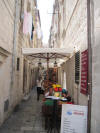
E013
 E014
E014
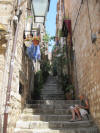 E015
E015

Part way up E016
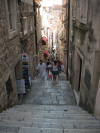
In his guidebook, Rick Steves recommended the “best” ice
cream at Dolce Vita on one of the side streets. They got to know me there.
Entrance to Dolce Vita E017
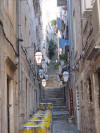
Here is the wall that surrounds Old Town.
E018
 E019
E019
 E020
E020

Dubrovnik’s single best attraction is to walk the scenic
1Ľ miles around the city walls on a path at the top of them. There have been
walls here since the start of the city, and they were beefed up in the 15th
century when the Ottoman navy became a threat.
I walked the walls early in the morning, before the
tourist crowds. It took me a full hour, as I took lots of pictures.
E021
 E022
E022

E023
 E024
E024
 E025
E025

There were lots and lots of stairs.
E026
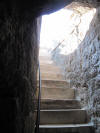
Here are some views from the path on the top of the
wall.
E027
 E028
E028
 E029
E029

E030 The Onofrio fountain with all the spigots

More views from the wall E031
 E032
E032

E033

In 1991, after Croatia declared independence from
Yugoslavia, the Serbs began bombing Dubrovnik during a siege of eight months.
The city held out and was liberated by the Croatian army. Most of the city was
rebuilt. The roofs that are lighter in color are the ones that had to be
replaced. The darker roofs were not damaged during the war. At the entrances to
the Old Town are maps indicating everywhere a bomb was dropped. Shells struck
68% of the 824 buildings.
More scenes from the wall walk.
E034
 E035
E035
 E036
E036
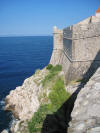
After I walked the wall, I went to the Fort of St.
Lawrence.
E037
 More stairs E038
More stairs E038
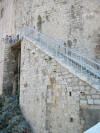 And more stairs E039
And more stairs E039

E040 Some stone cannonballs

At the top of the fort. The island in the background is
Lokrum, which I went to.
E041

From the ferry to Lokrum. Note the rocky shore. Most of
the island shores were like this. The island was open only during the day, and
you had to take the ferry back before it got dark.
E042 Looking back at Dubrovnik
 E043 The shore
E043 The shore 
E044 A path on the island

I went swimming on the island. One place was for
nudists, of which there are no pictures. But the rock "beach" looked just like
these, where I also swam.
E045
 E046
E046
 E047
E047

Cement “beaches” E048
 E049
E049

I took the cable car up to Mount Srd. I was going to
walk it, but when I got to the trailhead, it was virtually impassable.
E050
 E051
E051
 E052
E052

E053
 E054
E054

The large peninsula from Dubrovnik is Lapad. I learned
to use the buses, and took one to here. There was a beach at Lapad Bay with a
mixture of sand and pebbles. Most of the toddlers enjoyed clothes-free freedom.
I saw one woman sunbathing topless. The swimming was great. I did a couple of
laps from one side of the bay to the other.
E055
 E056
E056
 E057
E057

One of the tallest “hills” on the peninsula is Velika
Petka. I walked past the “No admission” sign (in four languages) and took a very
pleasant walk up to the top, where there were transmission towers. I loved the
smell of pine trees on this road.
E058
 E059
E059
 E060
E060

View from the top E061
 E062
E062

The water of the Adriatic Sea is such a pretty blue.
This time of year in Dubrovnik they have a Summer
Festival, with concerts, dances, and dramas for a month. I went to hear a
chamber quartet at the Rector’s palace. It was very nice.
E063 Rector’s palace

The performance E064
 E065
E065
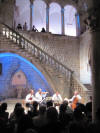
One morning I visited the Dominican Monastery, which was
nice and peaceful.
E066
 E067
E067

One day in the middle of my Dubrovnik stay I took a day
trip excursion to Montenegro, shown on another page.
When I finished my stay in Dubrovnik, I went to Hungary.
That's all for Dubrovnik.
